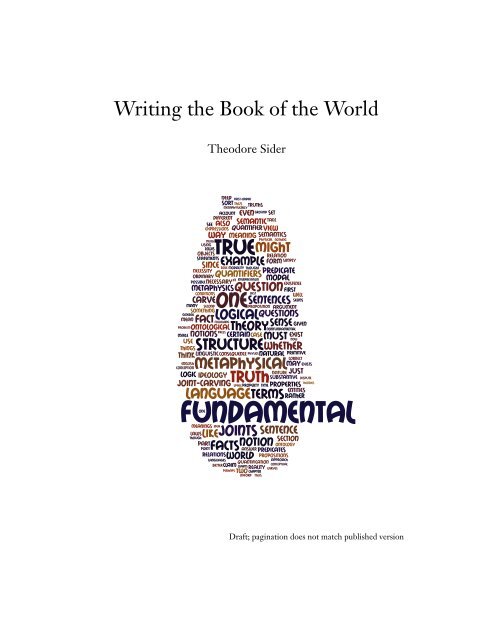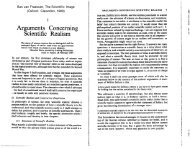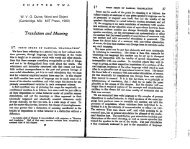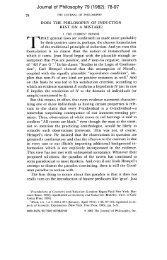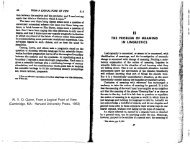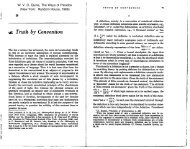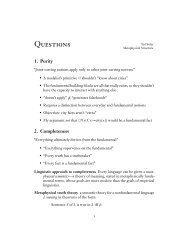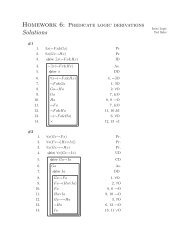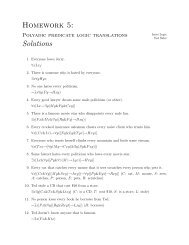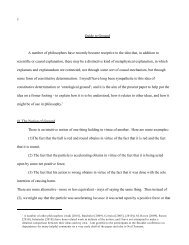Writing the Book of the World - Ted Sider
Writing the Book of the World - Ted Sider
Writing the Book of the World - Ted Sider
Create successful ePaper yourself
Turn your PDF publications into a flip-book with our unique Google optimized e-Paper software.
<strong>Writing</strong> <strong>the</strong> <strong>Book</strong> <strong>of</strong> <strong>the</strong> <strong>World</strong><br />
Theodore <strong>Sider</strong><br />
Draft; pagination does not match published version
The central <strong>the</strong>me <strong>of</strong> this book is: realism about structure. The world has<br />
a distinguished structure, a privileged description. For a representation to be<br />
fully successful, truth is not enough; <strong>the</strong> representation must also use <strong>the</strong> right<br />
concepts, so that its conceptual structure matches reality’s structure. There is<br />
an objectively correct way to “write <strong>the</strong> book <strong>of</strong> <strong>the</strong> world”.<br />
Realism about predicate structure is fairly widely accepted. Many—especially<br />
those influenced by David Lewis—think that some predicates (like ‘green’) do<br />
a better job than o<strong>the</strong>rs (like ‘grue’) at marking objective similarities, carving<br />
nature at <strong>the</strong> joints. But this realism should be extended, beyond predicates, to<br />
expressions <strong>of</strong> o<strong>the</strong>r grammatical categories, including logical expressions. Let<br />
“<strong>the</strong>re schmexists an F ” mean that <strong>the</strong> property <strong>of</strong> being an F is expressed by<br />
some predicate in some sentence <strong>of</strong> this book. ‘Schmexists’ does not carve at<br />
<strong>the</strong> joints; it is to <strong>the</strong> quantifier ‘<strong>the</strong>re exists’ as ‘grue’ is to ‘green’. Likewise,<br />
<strong>the</strong> question <strong>of</strong> joint-carving can be raised for predicate modifiers, sentential<br />
connectives, and expressions <strong>of</strong> o<strong>the</strong>r grammatical categories. (Structure is a<br />
generalization and extension <strong>of</strong> Lewisian naturalness.)<br />
I connect structure to fundamentality. The joint-carving notions are <strong>the</strong><br />
fundamental notions; a fact is fundamental when it is stated in joint-carving<br />
terms. A central task <strong>of</strong> metaphysics has always been to discern <strong>the</strong> ultimate<br />
or fundamental reality underlying <strong>the</strong> appearances. I think <strong>of</strong> this task as <strong>the</strong><br />
investigation <strong>of</strong> reality’s structure.<br />
Questions about which expressions carve at <strong>the</strong> joints are questions about<br />
how much structure reality contains. Whe<strong>the</strong>r reality contains causal, or ontological,<br />
or modal structure is a matter <strong>of</strong> whe<strong>the</strong>r causal predicates, quantifiers<br />
(or names), and modal operators carve at <strong>the</strong> joints. Such questions lie at <strong>the</strong><br />
center <strong>of</strong> metametaphysics. Those who say that questions <strong>of</strong> ontology are<br />
“merely verbal”, for example, are best regarded as holding that reality lacks<br />
ontological structure. Such deflationary metametaphysical stances are thus<br />
<strong>the</strong>mselves metaphysical stances. There is no ametaphysical Archimedean<br />
point from which to advance deflationary metametaphysics, since any such<br />
metametaphysics is committed to at least this much substantive metaphysics:<br />
reality lacks a certain sort <strong>of</strong> structure.<br />
A subsidiary <strong>the</strong>me is: ideology matters. There is an unfortunate tendency,<br />
perhaps encouraged by bad terminology, to psychologize Quine’s notion <strong>of</strong><br />
ideology: to regard a <strong>the</strong>ory’s choice <strong>of</strong> primitive notions—its ideology—as<br />
a merely psychological or linguistic or conventional matter (in contrast to<br />
<strong>the</strong> entities it postulates—its ontology—which is part <strong>of</strong> its objective content).<br />
Philosophers reject <strong>the</strong>ir opponents’ ideology in psychological/semantic terms:<br />
i
“I don’t understand what you mean by that.” And when introducing <strong>the</strong>ir own<br />
ideology, <strong>the</strong> hurdle to be passed is again psychological/semantic: primitive<br />
notions must be “intelligible”. But <strong>the</strong>re is a squarely metaphysical issue concerning<br />
any proposed piece <strong>of</strong> ideology (including logical and quasi-logical<br />
ideology such as modal operators or second-order quantifiers): does reality<br />
contain <strong>the</strong> requisite structure? If it does, <strong>the</strong>n “intelligibility” in previously<br />
“understood” terms is not required for successful reference to and <strong>the</strong>orizing<br />
about that structure, no more in metaphysics than in physics.<br />
A shift <strong>of</strong> focus from psychological/semantic to metaphysical constraints<br />
on ideology is at times liberating for metaphysics, but it also keeps our feet on<br />
<strong>the</strong> ground, by restraining <strong>the</strong> tendency to evade ontological commitments by<br />
adding to ideology. A fundamental <strong>the</strong>ory’s ideology is as much a part <strong>of</strong> its<br />
representational content as its ontology, for it represents <strong>the</strong> world as having<br />
structure corresponding to its primitive expressions. And <strong>the</strong> world according<br />
to an ideologically bloated <strong>the</strong>ory has a vastly more complex structure than <strong>the</strong><br />
world according to an ideologically leaner <strong>the</strong>ory; such complexity is not to be<br />
posited lightly.<br />
Fixating on ontology while ignoring ideology is both too narrow and incautious.<br />
1 It is too narrow because <strong>the</strong> goal <strong>of</strong> metaphysics is to give a fundamental<br />
description <strong>of</strong> <strong>the</strong> world, and doing so requires more than merely saying what<br />
<strong>the</strong>re is. It is incautious because it uncritically assumes that quantificational<br />
structure is fundamental. If quantificational structure is indeed fundamental<br />
(as I think it is), ontology deserves its place in fundamental metaphysics. But if<br />
quantificational structure is not fundamental, <strong>the</strong>n ontological inquiry deserves<br />
little more attention within fundamental metaphysics than inquiry into <strong>the</strong><br />
nature <strong>of</strong> catcher’s mitts.<br />
A final <strong>the</strong>me is a “pure” conception <strong>of</strong> metaphysics, free <strong>of</strong> certain encumbrances.<br />
One encumbrance is doing metaphysics primarily in modal terms.<br />
Against this, <strong>the</strong>re is a growing consensus that modal notions are too coarse for<br />
metaphysics, and that notions in <strong>the</strong> vicinity <strong>of</strong> “fundamentality”, “in virtue <strong>of</strong>”,<br />
and <strong>the</strong> like, should not be understood in modal terms. A second encumbrance<br />
is linguistic entanglements. Here too, <strong>the</strong>re is a growing consensus: that it is<br />
not so important for metaphysical and linguistic <strong>the</strong>ory to neatly mesh. The<br />
fundamental metaphysics underlying a discourse might have a structure quite<br />
unlike that suggested by <strong>the</strong> discourse. Whereas a good linguistic <strong>the</strong>ory must<br />
1 Dorr (2004, section 1) and Schaffer (2009a) make related complaints.<br />
ii
fit <strong>the</strong> suggested structure, good metaphysics must fit <strong>the</strong> underlying structure. 2<br />
This book presented an organizational challenge. Theory-<strong>the</strong>n-applications<br />
would have been neatest, but <strong>the</strong> concept <strong>of</strong> structure is unfamiliar enough that<br />
readability demanded early applications. My compromise was to intermingle.<br />
Chapter 1 introduces <strong>the</strong> concept <strong>of</strong> structure and describes in a preliminary<br />
way how it will be applied. Chapter 2 begins to present <strong>the</strong> <strong>the</strong>ory, arguing<br />
that structure is primitive and objective, and defending an epistemology <strong>of</strong><br />
structure. Chapters 3–5 turn to applications, showing how structure illuminates<br />
explanation and laws, reference, epistemology, physical geometry, substantivity,<br />
and metametaphysics. Chapters 6–8 return to <strong>the</strong>ory, arguing that expressions<br />
<strong>of</strong> any grammatical category (not just predicates) can be evaluated for structure,<br />
addressing various abstract questions about how structure behaves, and<br />
criticizing certain rival concepts (such as truthmaking and ground). Chapters<br />
9–12 return to applications, showing how <strong>the</strong> metaphysics <strong>of</strong> four domains—<br />
ontology, logic, time, and modality—looks when conceptualized in terms <strong>of</strong><br />
structure. Chapter 13 concludes with a sketch <strong>of</strong> a “worldview”: a comprehensive<br />
metaphysics cast in terms <strong>of</strong> structure. As a guide to those who wish to<br />
read selectively:<br />
The metaphysics <strong>of</strong> structure: chapters 1, 2, 6–8;<br />
Applications: chapters 3–5, 9–12;<br />
Metametaphysics: chapters 4–5, 9, and (to a lesser extent) 10–12;<br />
Mix <strong>of</strong> first-order and meta- metaphysics: chapters 9–13.<br />
I am grateful to many people for helpful discussions and feedback: Frank<br />
Arntzenius, Elizabeth Barnes, Paul Boghossian, Craig Callender, Ross Cameron,<br />
David Chalmers, David Copp, Troy Cross, Louis deRosset, Janelle Derstine,<br />
Cian Dorr, Ant Eagle, Andy Egan, Matti Eklund, Adam Elga, Matt Evans,<br />
Delia Graff Fara, Mike Fara, Hartry Field, Hilary Greaves, Liz Harman, Allan<br />
Hazlett, Eli Hirsch, Thomas H<strong>of</strong>weber, Paul Horwich, Alex Jackson, Carrie<br />
Jenkins, Boris Kment, Tora Koyama, Uriah Kriegel, Hea<strong>the</strong>r Logue, Ofra<br />
Magidor, Ishani Maitra, Colin Marshall, Farid Masrour, Andy McGonigal,<br />
Ian McKay, Joseph Melia, Ulrich Meyer, Alan Musgrave, Daniel Nolan, Jill<br />
North, Tim O’Connor, Laurie Paul, Zach Perry, Agustín Rayo, Tony Roark,<br />
2 Kit Fine’s (1994a; 2001) recent work has been especially influential in forging both con-<br />
sensuses.<br />
iii
Dan Rothschild, Stephen Schiffer, Michael Schweiger, Adam Sennet, Alan<br />
Sidelle, David Sosa, Ernie Sosa, Joshua Spencer, Jason Stanley, Irem Kurtsal<br />
Steen, Steve Steward, Sharon Street, Zoltán Gendler Szabó, Amie Thomasson,<br />
Jason Turner, Ryan Wasserman, Brian Wea<strong>the</strong>rson, Ralph Wedgwood, Bruno<br />
Whittle, Tim Williamson, Tobias Wilsch, Chris Wüthrich, Stephen Yablo,<br />
and Dean Zimmerman. I’m especially grateful to Karen Bennett, Gideon<br />
Rosen, Jonathan Schaffer, and Robbie Williams for extensive and challenging<br />
comments (which, I fear, I have not fully addressed). Thanks also to Oxford<br />
University Press and to Blackwell Publishing for permission to include bits <strong>of</strong><br />
<strong>Sider</strong> (2003), <strong>Sider</strong> (2009), and <strong>Sider</strong> (2007a).<br />
I’d also like to thank Kit Fine, John Hawthorne, and Phillip Bricker. I’ve<br />
learned much from talking to Kit about fundamentality in <strong>the</strong> past few years,<br />
and from thinking through his writings on <strong>the</strong> subject. John read large portions<br />
<strong>of</strong> <strong>the</strong> manuscript and gave me many insightful comments, as well as pushing<br />
me, years ago, to go beyond <strong>the</strong> predicate. Phil directed my dissertation, which<br />
was on Lewisian naturalness. He taught me <strong>the</strong> power <strong>of</strong> this idea, how to apply<br />
it to <strong>the</strong> philosophy <strong>of</strong> space and time, and much, much more. My intellectual<br />
debt to Phil is massive.<br />
Finally, it should be obvious how much this book owes to David Lewis. His<br />
ideas on natural properties and relations have always seemed to me among his<br />
best: powerful, correct, revolutionary yet deeply intuitive.<br />
iv
Contents<br />
1 Structure 1<br />
1.1 Structure: a first look . . . . . . . . . . . . . . . . . . . . . . . . . . . 1<br />
1.2 Philosophical skepticism about structure . . . . . . . . . . . . . . 3<br />
1.3 Structure in metaphysics . . . . . . . . . . . . . . . . . . . . . . . . . 6<br />
2 Primitivism 11<br />
2.1 Understanding . . . . . . . . . . . . . . . . . . . . . . . . . . . . . . . 11<br />
2.2 Primitivism supported . . . . . . . . . . . . . . . . . . . . . . . . . . 12<br />
2.3 Epistemology . . . . . . . . . . . . . . . . . . . . . . . . . . . . . . . . 14<br />
2.4 Against reduction . . . . . . . . . . . . . . . . . . . . . . . . . . . . . . 18<br />
2.5 Against subjectivity . . . . . . . . . . . . . . . . . . . . . . . . . . . . . 22<br />
2.6 The privilege <strong>of</strong> <strong>the</strong> physical . . . . . . . . . . . . . . . . . . . . . . 23<br />
3 Connections 25<br />
3.1 Explanation and laws . . . . . . . . . . . . . . . . . . . . . . . . . . . 25<br />
3.2 Reference magnetism . . . . . . . . . . . . . . . . . . . . . . . . . . . 28<br />
3.3 Induction and confirmation . . . . . . . . . . . . . . . . . . . . . . . 41<br />
3.4 Intrinsic structure in physical spaces . . . . . . . . . . . . . . . . . 46<br />
4 Substantivity 52<br />
4.1 Nonsubstantive questions . . . . . . . . . . . . . . . . . . . . . . . . 52<br />
4.2 Substantivity characterized . . . . . . . . . . . . . . . . . . . . . . . 54<br />
4.3 Conventionality . . . . . . . . . . . . . . . . . . . . . . . . . . . . . . . 64<br />
4.4 Subjectivity . . . . . . . . . . . . . . . . . . . . . . . . . . . . . . . . . . 67<br />
4.5 Epistemic value . . . . . . . . . . . . . . . . . . . . . . . . . . . . . . . 72<br />
4.6 Objectivity <strong>of</strong> structure . . . . . . . . . . . . . . . . . . . . . . . . . . 77<br />
v
CONTENTS vi<br />
5 Metametaphysics 79<br />
5.1 The challenge <strong>of</strong> metaphysical deflationism . . . . . . . . . . . . 79<br />
5.2 Personal identity, causation . . . . . . . . . . . . . . . . . . . . . . . 86<br />
5.3 The metaphysics room . . . . . . . . . . . . . . . . . . . . . . . . . . 87<br />
5.4 Substantivity in nonfundamental disputes . . . . . . . . . . . . . . 91<br />
5.5 Extended simples . . . . . . . . . . . . . . . . . . . . . . . . . . . . . . 93<br />
5.6 Metametaphysics as just more metaphysics . . . . . . . . . . . . . 97<br />
6 Beyond <strong>the</strong> predicate 100<br />
6.1 The reason to generalize . . . . . . . . . . . . . . . . . . . . . . . . . 101<br />
6.2 Inapplicability <strong>of</strong> <strong>the</strong> similarity test . . . . . . . . . . . . . . . . . . 103<br />
6.3 No entities . . . . . . . . . . . . . . . . . . . . . . . . . . . . . . . . . . 106<br />
6.4 Unclear epistemology? . . . . . . . . . . . . . . . . . . . . . . . . . . 114<br />
6.5 Logical conventionalism . . . . . . . . . . . . . . . . . . . . . . . . . 115<br />
7 Questions 124<br />
7.1 Complete? . . . . . . . . . . . . . . . . . . . . . . . . . . . . . . . . . . 124<br />
7.2 Pure? . . . . . . . . . . . . . . . . . . . . . . . . . . . . . . . . . . . . . . 126<br />
7.3 Purity and connection . . . . . . . . . . . . . . . . . . . . . . . . . . . 129<br />
7.4 Metaphysical semantics . . . . . . . . . . . . . . . . . . . . . . . . . . 132<br />
7.5 Completeness and purity reformulated . . . . . . . . . . . . . . . 136<br />
7.6 Metaphysics after conceptual analysis . . . . . . . . . . . . . . . . 138<br />
7.7 Metaphysical semantics for quantifiers . . . . . . . . . . . . . . . . 140<br />
7.8 Metaphysics and <strong>the</strong> study <strong>of</strong> language . . . . . . . . . . . . . . . 144<br />
7.9 Nonfundamental ground . . . . . . . . . . . . . . . . . . . . . . . . . 147<br />
7.10 Subpropositional? . . . . . . . . . . . . . . . . . . . . . . . . . . . . . 151<br />
7.11 Absolute? . . . . . . . . . . . . . . . . . . . . . . . . . . . . . . . . . . . 152<br />
7.11.1 Absolutism and comparative structure . . . . . . . . . . 153<br />
7.11.2 Absolutism and infinite descent . . . . . . . . . . . . . . . 157<br />
7.12 Determinate? . . . . . . . . . . . . . . . . . . . . . . . . . . . . . . . . 162<br />
7.13 Fundamental? . . . . . . . . . . . . . . . . . . . . . . . . . . . . . . . . 163<br />
8 Rivals 168<br />
8.1 Fine’s concepts . . . . . . . . . . . . . . . . . . . . . . . . . . . . . . . 168<br />
8.2 First Finean view: grounding and reality . . . . . . . . . . . . . . 169<br />
8.2.1 Ground and purity . . . . . . . . . . . . . . . . . . . . . . . 170<br />
8.2.2 Ground and infinite descent . . . . . . . . . . . . . . . . . 172<br />
8.3 Second Finean view: reality . . . . . . . . . . . . . . . . . . . . . . . 174
CONTENTS vii<br />
8.3.1 Explanation <strong>of</strong> fundamental truths . . . . . . . . . . . . . 174<br />
8.3.2 Combinatorialism about fundamentality . . . . . . . . . 176<br />
8.3.3 Combinatorialism about determinacy . . . . . . . . . . . 178<br />
8.3.4 No fundamental truths . . . . . . . . . . . . . . . . . . . . 179<br />
8.3.5 Nihilism and deflationism . . . . . . . . . . . . . . . . . . 180<br />
8.4 Truthmaking . . . . . . . . . . . . . . . . . . . . . . . . . . . . . . . . . 181<br />
8.5 Truthmaking as a <strong>the</strong>ory <strong>of</strong> fundamentality . . . . . . . . . . . . . 186<br />
8.6 Schaffer: entity-grounding . . . . . . . . . . . . . . . . . . . . . . . . 192<br />
8.7 Entity-fundamentality . . . . . . . . . . . . . . . . . . . . . . . . . . . 195<br />
9 Ontology 197<br />
9.1 Ontological deflationism . . . . . . . . . . . . . . . . . . . . . . . . . 199<br />
9.2 Ontological realism . . . . . . . . . . . . . . . . . . . . . . . . . . . . 200<br />
9.3 Ontologese . . . . . . . . . . . . . . . . . . . . . . . . . . . . . . . . . . 203<br />
9.4 Predicates not <strong>the</strong> issue . . . . . . . . . . . . . . . . . . . . . . . . . . 205<br />
9.5 Quantifier variance . . . . . . . . . . . . . . . . . . . . . . . . . . . . . 208<br />
9.5.1 Quantifier variance and domain restriction . . . . . . . 211<br />
9.6 Objections to quantifier variance . . . . . . . . . . . . . . . . . . . 215<br />
9.6.1 The semantic argument . . . . . . . . . . . . . . . . . . . . 215<br />
9.6.2 No foundation . . . . . . . . . . . . . . . . . . . . . . . . . . 217<br />
9.6.3 No epistemic high ground . . . . . . . . . . . . . . . . . . 222<br />
9.6.4 Indispensability . . . . . . . . . . . . . . . . . . . . . . . . . 223<br />
9.7 Easy ontology . . . . . . . . . . . . . . . . . . . . . . . . . . . . . . . . 224<br />
9.8 Analyticity . . . . . . . . . . . . . . . . . . . . . . . . . . . . . . . . . . 227<br />
9.9 Against easy ontology . . . . . . . . . . . . . . . . . . . . . . . . . . . 233<br />
9.10 O<strong>the</strong>r forms <strong>of</strong> easy ontology . . . . . . . . . . . . . . . . . . . . . . 234<br />
9.11 Metaontology and conceptions <strong>of</strong> fundamentality . . . . . . . . 237<br />
9.12 Ontological commitment . . . . . . . . . . . . . . . . . . . . . . . . 240<br />
9.13 Quantifiers versus terms . . . . . . . . . . . . . . . . . . . . . . . . . 242<br />
9.14 NonQuinean first-order ontology . . . . . . . . . . . . . . . . . . . 246<br />
9.15 Higher-order quantification . . . . . . . . . . . . . . . . . . . . . . . 247<br />
10 Logic 256<br />
10.1 Fundamental logic . . . . . . . . . . . . . . . . . . . . . . . . . . . . . 256<br />
10.2 Hard choices . . . . . . . . . . . . . . . . . . . . . . . . . . . . . . . . . 257<br />
10.3 Nonfundamental metalogic . . . . . . . . . . . . . . . . . . . . . . . 264<br />
10.4 Logical pluralism . . . . . . . . . . . . . . . . . . . . . . . . . . . . . . 267<br />
10.5 Objectivity in model <strong>the</strong>ory . . . . . . . . . . . . . . . . . . . . . . . 270
CONTENTS viii<br />
10.6 Classical logic and fundamentality . . . . . . . . . . . . . . . . . . 273<br />
11 Time 284<br />
11.1 Presentism . . . . . . . . . . . . . . . . . . . . . . . . . . . . . . . . . . 284<br />
11.2 Presentist ideology: quantified tense logic . . . . . . . . . . . . . 285<br />
11.3 Is dispute over presentism substantive? . . . . . . . . . . . . . . . 288<br />
11.4 Passage . . . . . . . . . . . . . . . . . . . . . . . . . . . . . . . . . . . . . 292<br />
11.5 Williamson on saturation and contingency . . . . . . . . . . . . . 294<br />
11.6 Change and saturation . . . . . . . . . . . . . . . . . . . . . . . . . . 297<br />
11.7 Talk <strong>of</strong> saturation is legitimate . . . . . . . . . . . . . . . . . . . . . 298<br />
11.8 The metaphysics <strong>of</strong> saturation . . . . . . . . . . . . . . . . . . . . . 301<br />
11.9 Varieties <strong>of</strong> passage . . . . . . . . . . . . . . . . . . . . . . . . . . . . . 306<br />
12 Modality 316<br />
12.1 No fundamental modality . . . . . . . . . . . . . . . . . . . . . . . . 316<br />
12.2 A Humean strategy for reduction . . . . . . . . . . . . . . . . . . . 318<br />
12.3 Logical consequence and ma<strong>the</strong>matical truth . . . . . . . . . . . 323<br />
12.4 Analyticity . . . . . . . . . . . . . . . . . . . . . . . . . . . . . . . . . . 326<br />
12.5 Laws <strong>of</strong> metaphysics . . . . . . . . . . . . . . . . . . . . . . . . . . . . 326<br />
12.6 Determinates and determinables . . . . . . . . . . . . . . . . . . . . 331<br />
12.7 Contextualism . . . . . . . . . . . . . . . . . . . . . . . . . . . . . . . . 333<br />
12.8 The necessary a posteriori . . . . . . . . . . . . . . . . . . . . . . . . 335<br />
12.9 Micro-reduction . . . . . . . . . . . . . . . . . . . . . . . . . . . . . . 337<br />
12.10 De re modality . . . . . . . . . . . . . . . . . . . . . . . . . . . . . . . 341<br />
12.11 Family resemblances . . . . . . . . . . . . . . . . . . . . . . . . . . . . 343<br />
12.12 Spreading arbitrariness . . . . . . . . . . . . . . . . . . . . . . . . . . 344<br />
13 A <strong>World</strong>view 347
Chapter 1<br />
Structure<br />
Metaphysics, at bottom, is about <strong>the</strong> fundamental structure <strong>of</strong> reality. Not<br />
about what’s necessarily true. Not about what properties are essential.<br />
Not about conceptual analysis. Not about what <strong>the</strong>re is. Structure.<br />
Inquiry into necessity, essence, concepts, or ontology might help to illuminate<br />
reality’s structure. But <strong>the</strong> ultimate goal is insight into this structure<br />
itself—insight into what <strong>the</strong> world is like, at <strong>the</strong> most fundamental level.<br />
1.1 Structure: a first look<br />
Discerning “structure” means discerning patterns. It means figuring out <strong>the</strong><br />
right categories for describing <strong>the</strong> world. It means “carving reality at its joints”,<br />
to paraphrase Plato. It means inquiring into how <strong>the</strong> world fundamentally is,<br />
as opposed to how we ordinarily speak or think <strong>of</strong> it.<br />
Consider three objects: two electrons in identical intrinsic states, and a cow.<br />
It is <strong>the</strong> most natural thing in <strong>the</strong> world to say that <strong>the</strong> electrons are perfectly<br />
similar to each o<strong>the</strong>r, and that nei<strong>the</strong>r is perfectly similar to <strong>the</strong> cow. The three<br />
objects should be divided into two groups, one containing <strong>the</strong> electrons, <strong>the</strong><br />
o<strong>the</strong>r containing <strong>the</strong> cow. The electrons go toge<strong>the</strong>r, and nei<strong>the</strong>r goes with <strong>the</strong><br />
cow.<br />
Or imagine a universe that is entirely full <strong>of</strong> fluid. A plane divides <strong>the</strong><br />
universe into two halves, one in which <strong>the</strong> fluid is uniformly red, <strong>the</strong> o<strong>the</strong>r<br />
in which <strong>the</strong> fluid is uniformly blue (figure 1.1). Now imagine a group <strong>of</strong><br />
people who encounter this universe, but accord no special status to <strong>the</strong> dividing<br />
blue-red plane. Instead <strong>of</strong> thinking <strong>of</strong> <strong>the</strong> universe as divided into <strong>the</strong> red and<br />
1
CHAPTER 1. STRUCTURE 2<br />
Figure 1.1: The red–blue world<br />
Figure 1.2: Bizarre carving <strong>of</strong> <strong>the</strong> red–blue world<br />
blue halves, <strong>the</strong>y think <strong>of</strong> it as being divided in half by a different plane, marked<br />
by <strong>the</strong> dashed line in figure 1.2. And <strong>the</strong>y do not use predicates for red and<br />
blue. Instead, <strong>the</strong>y have a pair <strong>of</strong> predicates that <strong>the</strong>y apply uniformly within<br />
<strong>the</strong> two regions separated by <strong>the</strong>ir dividing plane. These predicates (whose<br />
extensions are indicated by diagonal hash lines in <strong>the</strong> diagram) cut across <strong>the</strong><br />
predicates ‘red’ and ‘blue’. The regions to <strong>the</strong> left <strong>of</strong> <strong>the</strong> dashed line <strong>the</strong>y call<br />
“bred”; <strong>the</strong> regions to <strong>the</strong> right <strong>the</strong>y call “rue”.<br />
It is almost irresistible to describe <strong>the</strong>se people as making a mistake. But<br />
<strong>the</strong>y’re not making a mistake about where <strong>the</strong> red and blue regions are, since<br />
<strong>the</strong>y make no claims about red or blue. And <strong>the</strong>y make no mistakes when <strong>the</strong>y<br />
apply <strong>the</strong>ir own concepts. The regions that <strong>the</strong>y call “bred” are indeed bred,<br />
and <strong>the</strong> regions <strong>the</strong>y call “rue” are indeed rue. The problem is that <strong>the</strong>y’ve
CHAPTER 1. STRUCTURE 3<br />
got <strong>the</strong> wrong concepts. They’re carving <strong>the</strong> world up incorrectly. By failing<br />
to think in terms <strong>of</strong> <strong>the</strong> red/blue dividing plane, <strong>the</strong>y are missing something.<br />
Although <strong>the</strong>ir beliefs are true, those beliefs do not match <strong>the</strong> world’s structure.<br />
1.2 Philosophical skepticism about structure<br />
All is well until we encounter a philosopher, who, as usual, asks some uncomfortable<br />
questions. Why do <strong>the</strong> two electrons “go toge<strong>the</strong>r”, <strong>the</strong> philosopher<br />
wants to know? Yes, <strong>the</strong>y share many features in common: each has 1.602×10 −19<br />
C charge, 9.109 × 10 −31 kg mass, and so on. But <strong>the</strong>re are plenty <strong>of</strong> features<br />
that <strong>the</strong> electrons do not share. They are in different locations, travel at different<br />
velocities, and are parts <strong>of</strong> different wholes. And why doesn’t <strong>the</strong> cow go<br />
toge<strong>the</strong>r with <strong>the</strong> electrons? If all three are located in North America, <strong>the</strong>n all<br />
three share <strong>the</strong> feature being located in North America. And all three share <strong>the</strong><br />
feature: being an electron or a cow.<br />
The philosopher continues: what is wrong with carving <strong>the</strong> red–blue world<br />
along <strong>the</strong> diagonal plane? What is wrong with grouping <strong>the</strong> bred things<br />
toge<strong>the</strong>r and <strong>the</strong> rue things toge<strong>the</strong>r? All bred things really are bred; <strong>the</strong>y all<br />
share <strong>the</strong> feature <strong>of</strong> being on <strong>the</strong> left side <strong>of</strong> <strong>the</strong> diagonal plane. One might protest<br />
that not all bred things are alike, since some are red and some are blue; but<br />
<strong>the</strong> philosopher will reply that carving <strong>the</strong> world along <strong>the</strong> vertical plane is no<br />
better on this score. Not all red things are alike, since some are bred and some<br />
are rue.<br />
In fact, once we get <strong>the</strong> hang <strong>of</strong> <strong>the</strong> philosopher’s way <strong>of</strong> thinking about<br />
“features”, we can see that any two objects share infinitely many features, and<br />
also differ with respect to infinitely many features. For consider any objects<br />
x and y. Where F x and F y are any features <strong>of</strong> x and y, respectively, x and y<br />
share <strong>the</strong> feature: being ei<strong>the</strong>r F x or F y . And <strong>the</strong>y share <strong>the</strong> feature being ei<strong>the</strong>r F x<br />
or F y or 1 kg mass. And <strong>the</strong>y share <strong>the</strong> feature being ei<strong>the</strong>r F x or F y or 2 kg mass.<br />
And so on. So <strong>the</strong>y share infinitely many features. As for <strong>the</strong> infinitely many<br />
features with respect to which <strong>the</strong>y differ, consider:<br />
being F x , and located at L<br />
being F x -or-1-kg-mass, and located at L<br />
being F x -or-2-kg-mass, and located at L
CHAPTER 1. STRUCTURE 4<br />
etc.<br />
where L is some location occupied by x but not y. Object x has each <strong>of</strong> <strong>the</strong>se<br />
features; object y lacks each.<br />
The crux is obviously <strong>the</strong> philosopher’s willingness to allow such “features”<br />
as being ei<strong>the</strong>r an electron or a cow, and to treat <strong>the</strong>m on a par with features like<br />
being an electron and being a cow. If we had nothing but <strong>the</strong> philosopher’s features<br />
to go by, <strong>the</strong>n indeed, we wouldn’t be able to make any sense <strong>of</strong> a “correct” way<br />
to group our three objects, or <strong>of</strong> <strong>the</strong> electrons being more similar to each o<strong>the</strong>r<br />
than to <strong>the</strong> cow. If, on <strong>the</strong> o<strong>the</strong>r hand, we could make a distinction between<br />
genuine features—features that are fundamental, that carve nature at <strong>the</strong> joints,<br />
whose sharing makes for similarity—and <strong>the</strong> rest, <strong>the</strong>n we could say what we<br />
want. Can we make this distinction?<br />
Concepts and distinctions that resist definition in terms <strong>of</strong> <strong>the</strong> popular<br />
philosophical ideology <strong>of</strong> <strong>the</strong> day tend to be viewed with suspicion. Thus<br />
it was that throughout much <strong>of</strong> <strong>the</strong> twentieth century, philosophers tended<br />
not to speak <strong>of</strong> genuine features. Quine’s extensionalism, for example, which<br />
dominated <strong>the</strong> 1950s and 1960s, allowed only a meager set <strong>of</strong> concepts to be<br />
used in drawing distinctions (roughly, those <strong>of</strong> first-order logic plus an array <strong>of</strong><br />
scientific predicates). Noticing <strong>the</strong> presence <strong>of</strong> disjunction in <strong>the</strong> definitions<br />
<strong>of</strong> many philosopher’s features, an extensionalist might begin an attempt to<br />
characterize genuineness by disqualifying features defined in this way. But what<br />
language do we use to evaluate whe<strong>the</strong>r a feature is “defined using disjunction”?<br />
Speakers <strong>of</strong> English must use ‘or’ to define <strong>the</strong> feature: being an electron or<br />
cow, but speakers <strong>of</strong> a language with a primitive predicate for this feature—<br />
‘blurg’, call it—can define <strong>the</strong> same extension without using ‘or’. Indeed, if <strong>the</strong><br />
language is strange enough, its speakers would need to use ‘or’ and o<strong>the</strong>r logical<br />
connectives to say things that in English may be said using simple predicates<br />
like ‘cow’ and ‘electron’, just as we must use logically complex predicates <strong>of</strong><br />
English to say what <strong>the</strong>y say using ‘blurg’. The extensionalist attempt fails to<br />
characterize an appropriately language-independent notion <strong>of</strong> genuineness. 1<br />
In <strong>the</strong> 1970s, modality became kosher ideology, and <strong>the</strong>re were renewed<br />
attempts to define concepts in <strong>the</strong> vicinity <strong>of</strong> structure. For instance, Roderick<br />
1 The paradigm <strong>of</strong> first-order logic had perhaps <strong>the</strong> following additional influence. The<br />
standard model <strong>the</strong>ory <strong>of</strong> first-order logic treats <strong>the</strong> semantic values <strong>of</strong> (n-place) predicates as<br />
subsets <strong>of</strong> <strong>the</strong> (n-place Cartesian product <strong>of</strong> <strong>the</strong>) domain. Viewed from a purely set-<strong>the</strong>oretic<br />
perspective, <strong>the</strong> semantic values <strong>of</strong> <strong>the</strong> predicates ‘is an electron’ and ‘is an electron or cow’ are<br />
on a par: each is a subset <strong>of</strong> <strong>the</strong> domain.
CHAPTER 1. STRUCTURE 5<br />
Chisholm (1976, p. 127) and Jaegwon Kim (1982, pp. 59-60) tried to give a<br />
modal definition <strong>of</strong> <strong>the</strong> notion <strong>of</strong> an intrinsic property—a property that an object<br />
has just by virtue <strong>of</strong> what it’s like in itself, independently <strong>of</strong> how it is related<br />
to o<strong>the</strong>r objects. They proposed, roughly, that a property is intrinsic if and<br />
only if it is possibly instantiated by an object that is alone in <strong>the</strong> world. But<br />
this definition was shown to be unacceptable. The property <strong>of</strong> being alone in<br />
<strong>the</strong> world, and <strong>the</strong> property <strong>of</strong> ei<strong>the</strong>r (being alone in <strong>the</strong> world and being green) or<br />
(not being alone in <strong>the</strong> world and being blue), satisfy <strong>the</strong> definition but are extrinsic<br />
(Lewis, 1983a).<br />
(The 70s’ fixation on modality was doubly unfortunate. Not only are<br />
modal tools too crude; 2 <strong>the</strong>y’re also distant from <strong>the</strong> subject matter <strong>of</strong> most<br />
<strong>of</strong> metaphysics. It is needlessly indirect to approach <strong>the</strong> question <strong>of</strong> what <strong>the</strong><br />
world is like by asking what it must be like and what it might have been like. 3 )<br />
Since <strong>the</strong> 1980s many philosophers have become comfortable with a richer<br />
ideology, one that includes notions in <strong>the</strong> vicinity <strong>of</strong> “genuine feature”, “intrinsic<br />
property”, and <strong>the</strong> like. The zeitgeist has been that <strong>the</strong>se notions are<br />
legitimate even if <strong>the</strong>y cannot be defined in o<strong>the</strong>r terms. Two Davids have led<br />
<strong>the</strong> way. 4 David Armstrong (1978a,b) used <strong>the</strong> traditional doctrine <strong>of</strong> universals<br />
to draw <strong>the</strong> distinction between genuine and nongenuine features. Some<br />
predicates, like ‘is an electron’, perhaps, stand for universals, Armstrong said;<br />
but o<strong>the</strong>rs do not: <strong>the</strong>re simply is no universal <strong>of</strong> “being ei<strong>the</strong>r a cow or an<br />
electron”. Through sheer force <strong>of</strong> will as much anything, he put realism about<br />
genuine features on <strong>the</strong> map. But as our second David, David Lewis (1983b)<br />
showed, Armstrong embedded this insight in a quite independent dialectic: <strong>the</strong><br />
traditional debate over <strong>the</strong> existence <strong>of</strong> universals and <strong>the</strong>ir role in a general<br />
analysis <strong>of</strong> predication. According to Lewis, we can incorporate Armstrong’s<br />
insight by admitting a notion <strong>of</strong> “natural properties and relations” (those properties<br />
and relations that carve nature at <strong>the</strong> joints) without thinking <strong>of</strong> <strong>the</strong>se<br />
as universals in <strong>the</strong> traditional sense, and without taking on <strong>the</strong> (misguided,<br />
according to Lewis) project <strong>of</strong> giving a general analysis <strong>of</strong> predication. The<br />
notion <strong>of</strong> a genuine feature was thus freed from unwanted entanglements.<br />
Of course, everyone can agree that <strong>the</strong>re is some difference between being an<br />
electron and being ei<strong>the</strong>r an electron or a cow. If nothing else, ordinary English<br />
2 On which see, for instance, Fine (1994a); Restall (1996).<br />
3 I also suspect that <strong>the</strong> right account <strong>of</strong> how <strong>the</strong> world might have been and must be defers<br />
to how <strong>the</strong> world is (chapter 12).<br />
4 Earlier relevant work includes Quinton (1958); Quine (1969); Putnam (1975d); Bealer<br />
(1982, chapter 8).
CHAPTER 1. STRUCTURE 6<br />
has a single word for <strong>the</strong> former attribute. What distinguishes Armstrong<br />
and Lewis is that <strong>the</strong>y regard <strong>the</strong> distinction as objective. Structure, too, is to<br />
be understood as objective. There are hard questions about what objectivity<br />
amounts to (some <strong>of</strong> which will be discussed in chapter 4), but <strong>the</strong> intuitive idea<br />
is clear: whe<strong>the</strong>r a property, word, or concept 5 carves at <strong>the</strong> joints has nothing<br />
to do with <strong>the</strong> place <strong>of</strong> <strong>the</strong> concept in human languages, conceptual schemes,<br />
biology, or anything like that. Thus “fundamental” (which I use more or less<br />
interchangeably with “joint-carving” and “part <strong>of</strong> reality’s structure”) signifies<br />
a metaphysical, ra<strong>the</strong>r than conceptual, sort <strong>of</strong> fundamentality. Humans may<br />
need to acquire o<strong>the</strong>r concepts first before <strong>the</strong>y grasp joint-carving ones; and<br />
conversely, those concepts we acquire first, or most easily, may fail to carve at<br />
<strong>the</strong> joints.<br />
1.3 Structure in metaphysics: a preview<br />
The goal <strong>of</strong> this book is to push forward <strong>the</strong> front <strong>of</strong> realism about structure.<br />
I want to expand our conception <strong>of</strong> structure’s importance, generalize<br />
<strong>the</strong> concept <strong>of</strong> structure, investigate its nature, use it as <strong>the</strong> foundation <strong>of</strong><br />
“metametaphysics”, and reconceptualize metaphysics in terms <strong>of</strong> it.<br />
The connection to similarity is only <strong>the</strong> beginning <strong>of</strong> <strong>the</strong> importance <strong>of</strong> <strong>the</strong><br />
notion <strong>of</strong> structure. As we will see, structure pops up throughout philosophy,<br />
in our thinking about reference, epistemology, spacetime, objectivity, and o<strong>the</strong>r<br />
matters.<br />
Structure is particularly central to metaphysics. The heart <strong>of</strong> metaphysics<br />
is <strong>the</strong> question: what is <strong>the</strong> world ultimately, or fundamentally, like? And<br />
fundamentality is a matter <strong>of</strong> structure: <strong>the</strong> fundamental facts are those cast in<br />
terms that carve at <strong>the</strong> joints.<br />
The truly central question <strong>of</strong> metaphysics is that <strong>of</strong> what is most fundamental.<br />
So in my terms, we must ask which notions carve perfectly at <strong>the</strong> joints. By using<br />
5 Subtleties will come later, but to forestall misunderstanding: 1. Structure is a worldly, not<br />
conceptual or linguistic, matter (my informal talk <strong>of</strong> “notion/word/concept X carves at <strong>the</strong><br />
joints” notwithstanding). 2. ‘Structure’ is not a noun; structure is not an entity or stuff (this<br />
very sentence, and phrases like “how much structure <strong>the</strong> world contains”, notwithstanding).<br />
3. ‘Structure’ and its variants are not predicates—not <strong>of</strong> properties, nor <strong>of</strong> any o<strong>the</strong>r sorts <strong>of</strong><br />
entities (“charge carves at <strong>the</strong> joints” notwithstanding). 4. My most basic notion <strong>of</strong> structure<br />
is absolute, although I allow a derivative notion that comes in degrees. 5. Structure includes<br />
distinguished monadic features (such as charge), not just relational ones (despite what may be<br />
suggested by <strong>the</strong> term ‘structure’).
CHAPTER 1. STRUCTURE 7<br />
‘red’ and ‘blue’, we carve more closely to reality’s joints than do <strong>the</strong> speakers <strong>of</strong><br />
<strong>the</strong> ‘bred’/‘rue’ language. But we do not <strong>the</strong>reby carve perfectly at <strong>the</strong> joints;<br />
colors are presumably not perfectly fundamental. To carve perfectly, one must<br />
use <strong>the</strong> most fundamental concepts, expressing <strong>the</strong> facets <strong>of</strong> reality that underly<br />
<strong>the</strong> colors.<br />
Which concepts are <strong>the</strong> perfectly fundamental ones? In my view, certain<br />
concepts <strong>of</strong> physics, logic, and ma<strong>the</strong>matics. 6 But this <strong>the</strong>sis about structure is<br />
not built into <strong>the</strong> idea <strong>of</strong> structure, and defending it is not one <strong>of</strong> <strong>the</strong> main goals<br />
<strong>of</strong> this book. The great metaphysical disputes concern which <strong>the</strong>ses <strong>of</strong> this sort<br />
are true; my goal is to explain what is at stake in such disputes, not to settle<br />
<strong>the</strong>m. Is mentality part <strong>of</strong> reality’s fundamental structure? (Modal <strong>the</strong>ses in <strong>the</strong><br />
philosophy <strong>of</strong> mind, such as psychophysical supervenience, are crude ways <strong>of</strong><br />
getting at what clearly was <strong>the</strong> issue all along: whe<strong>the</strong>r reality is fundamentally<br />
mental.) Do ma<strong>the</strong>matical entities exist, in <strong>the</strong> fundamental sense <strong>of</strong> ‘<strong>the</strong>re<br />
exist’, and if so, what are <strong>the</strong> fundamental features <strong>of</strong> those entities? Do causal<br />
or nomic notions have any place in a fundamental description <strong>of</strong> <strong>the</strong> world?<br />
These are questions about structure.<br />
Metametaphysics—inquiry into <strong>the</strong> status <strong>of</strong> metaphysics—will be central<br />
in this book. Is <strong>the</strong> pope (or Robinson Crusoe, or a twelve-year-old boy) a<br />
bachelor? Intuitively, <strong>the</strong> question is merely verbal or conceptual. To answer it,<br />
all we need to do is investigate our concept <strong>of</strong> a bachelor; intuitively, all that is<br />
at stake is how we use <strong>the</strong> word ‘bachelor’. In contrast, <strong>the</strong> question <strong>of</strong> whe<strong>the</strong>r<br />
<strong>the</strong>re is any lithium in a certain region on Mars has nothing to do with word<br />
use or concepts; it is substantive. This rough and ready notion <strong>of</strong> substantivity<br />
needs to be clarified; after all, <strong>the</strong> statement that Robinson Crusoe is a bachelor<br />
is no more about our concept <strong>of</strong> a bachelor than <strong>the</strong> statement that <strong>the</strong>re is<br />
lithium in <strong>the</strong> region is about our concept <strong>of</strong> lithium. Never<strong>the</strong>less, <strong>the</strong>re is a<br />
strong intuitive contrast between <strong>the</strong> two questions.<br />
The opponents <strong>of</strong> metaphysics (and even some renegade practitioners) tend<br />
to regard many metaphysical questions as being—to some extent, anyway—like<br />
<strong>the</strong> question <strong>of</strong> whe<strong>the</strong>r <strong>the</strong> pope is a bachelor. True believers, on <strong>the</strong> o<strong>the</strong>r<br />
hand, tend to think <strong>of</strong> <strong>the</strong>ir favorite metaphysical questions as being substantive,<br />
like <strong>the</strong> question about lithium. In my view, whe<strong>the</strong>r a question is substantive—<br />
in one important sense <strong>of</strong> ‘substantive’—depends largely on <strong>the</strong> extent to which<br />
its terms carve at <strong>the</strong> joints; to <strong>the</strong> extent, that is, that <strong>the</strong> question concerns<br />
<strong>the</strong> world’s fundamental structure. The central metametaphysical questions<br />
6 Plus <strong>the</strong> concept <strong>of</strong> structure itself! See section 7.13.
CHAPTER 1. STRUCTURE 8<br />
are about how much structure <strong>the</strong> world contains.<br />
Consider two properties:<br />
Being an unmarried male<br />
Being an unmarried adult male eligible for marriage.<br />
It may well be that exactly one <strong>of</strong> <strong>the</strong>se properties is (determinately) what we<br />
mean by ‘bachelor’. So it may be that <strong>the</strong> question <strong>of</strong> <strong>the</strong> pope’s bachelorhood<br />
has an answer. But nei<strong>the</strong>r <strong>of</strong> <strong>the</strong>se two properties carves nature at <strong>the</strong> joints<br />
better than <strong>the</strong> o<strong>the</strong>r. The unmarried males don’t go toge<strong>the</strong>r any more than<br />
do <strong>the</strong> unmarried males eligible for marriage. A linguistic community that<br />
used <strong>the</strong> word ‘bachelor’ for <strong>the</strong> first property would not be getting at <strong>the</strong><br />
world’s structure any better than a community that used <strong>the</strong> word for <strong>the</strong><br />
second property. And since <strong>the</strong> pope is an unmarried male who is ineligible for<br />
marriage, speakers <strong>of</strong> <strong>the</strong> first community speak truly when <strong>the</strong>y say ‘The pope<br />
is a bachelor’, whereas speakers <strong>of</strong> <strong>the</strong> second community speak truly when<br />
<strong>the</strong>y say ‘The pope is not a bachelor’. So, intuitively, <strong>the</strong> only question facing<br />
us is: which sort <strong>of</strong> linguistic community do we inhabit? Which <strong>of</strong> two equally<br />
good ways to talk is our way to talk?<br />
The question <strong>of</strong> whe<strong>the</strong>r <strong>the</strong>re is lithium in <strong>the</strong> region near Mars has a very<br />
different status. Suppose that <strong>the</strong> region does indeed contain lithium. We can<br />
imagine a linguistic community that uses <strong>the</strong> word ‘lithium’ exactly as we do,<br />
but with one exception: <strong>the</strong>ir word does not apply to <strong>the</strong> lithium (in our sense<br />
<strong>of</strong> <strong>the</strong> word) in <strong>the</strong> region. So ‘There is lithium in <strong>the</strong> region’ counts as true<br />
in our language, and false in <strong>the</strong>irs. But here <strong>the</strong> parallel with <strong>the</strong> previous<br />
paragraph ends. The lithium in <strong>the</strong> region is just like <strong>the</strong> lithium elsewhere,<br />
so <strong>the</strong> imagined linguistic community fails badly to carve nature at <strong>the</strong> joints.<br />
They fail to group toge<strong>the</strong>r things that, objectively, go toge<strong>the</strong>r. The question<br />
<strong>of</strong> whe<strong>the</strong>r <strong>the</strong>re is lithium in <strong>the</strong> region is not just a question <strong>of</strong> which <strong>of</strong> two<br />
equally good ways to talk is our way to talk.<br />
Few would deny that <strong>the</strong> question <strong>of</strong> <strong>the</strong> pope’s bachelorhood is insubstantial<br />
in a way that <strong>the</strong> question about lithium is not. But in metaphysics, things are<br />
far less clear. Consider questions <strong>of</strong> ontology, for example. There has been<br />
much discussion recently <strong>of</strong> whe<strong>the</strong>r tables and chairs and o<strong>the</strong>r composite<br />
material objects exist. It is generally common ground in <strong>the</strong>se discussions that<br />
<strong>the</strong>re exist subatomic particles that are “arranged tablewise” and “arranged<br />
chairwise”; <strong>the</strong> controversy is over whe<strong>the</strong>r <strong>the</strong>re exist in addition tables and<br />
chairs that are composed <strong>of</strong> <strong>the</strong> particles. Is this really a substantive debate
CHAPTER 1. STRUCTURE 9<br />
about <strong>the</strong> world? Most <strong>of</strong> <strong>the</strong> ontologists engaged in <strong>the</strong> debate think so—or<br />
really, presuppose so. But Eli Hirsch, Hilary Putnam, and o<strong>the</strong>r “ontological<br />
deflationists” have argued that <strong>the</strong> debate is in some sense merely verbal or<br />
conceptual. The “metaontological” question here ultimately boils down, I<br />
think, to a question <strong>of</strong> structure: whe<strong>the</strong>r quantificational notions like ‘<strong>the</strong>re<br />
exists’ carve at <strong>the</strong> joints. What <strong>the</strong> ontological deflationists have in effect been<br />
saying is that reality would need fundamental quantificational structure in order<br />
for <strong>the</strong> question <strong>of</strong> whe<strong>the</strong>r <strong>the</strong>re exist tables and chairs to be worth asking,<br />
and that this structure is, in fact, missing. I oppose ontological deflationists<br />
in chapter 9, but <strong>the</strong>y deserve credit for raising an important and difficult<br />
question—a question that is in a way more foundational than <strong>the</strong> first-order<br />
question <strong>of</strong> what <strong>the</strong>re is.<br />
There are similar foundational questions throughout metaphysics. Do<br />
modal concepts carve at <strong>the</strong> joints (chapter 12)? (Here my answer is no; modality<br />
is not <strong>the</strong> core <strong>of</strong> metaphysics that some take it to be.) Do tensed concepts<br />
(chaper 11)? (Again, no; but seeing <strong>the</strong> issue as concerning reality’s temporal<br />
joints helps to illuminate what are o<strong>the</strong>rwise extremely perplexing questions.)<br />
Do logical concepts (chapter 10)? (Here I say yes. Certain debates over <strong>the</strong><br />
“correct” logic are genuine, and are not linguistic or conceptual; <strong>the</strong>y are as<br />
substantive as ontological debates.)<br />
More generally, metaphysicians regularly speak <strong>of</strong> what is “really” or “genuinely”<br />
<strong>the</strong> case. (Often <strong>the</strong>y feel guilty about it, but don’t know how to stop.)<br />
As Kit Fine (2001, 2009) has emphasized, such talk is central to metaphysics,<br />
but in dire need <strong>of</strong> explication. When a nominalist says that <strong>the</strong>re do not really<br />
exist abstract entities like properties, while granting that frogs share more properties<br />
in common with crocodiles than <strong>the</strong>y share with humans, <strong>the</strong> ‘really’ is<br />
essential; o<strong>the</strong>rwise she contradicts herself. Those who think that “time is like<br />
space” say that <strong>the</strong>re is no “genuine” or “objective” distinction between past,<br />
present, and future, but <strong>the</strong>y do not deny that <strong>the</strong>re once were dinosaurs. Again,<br />
if ‘genuine’ and ‘objective’ are dropped <strong>the</strong>n <strong>the</strong> position becomes incoherent.<br />
These claims are not merely about what is true; <strong>the</strong>y are about what is true at<br />
<strong>the</strong> fundamental level.<br />
If <strong>the</strong> concept <strong>of</strong> structure is to play this role in metametaphysics, it must<br />
be generalized beyond Armstrong’s notion <strong>of</strong> a universal and Lewis’s notion<br />
<strong>of</strong> natural properties and relations. For many metaphysical questions are not<br />
about universals, properties, and relations. The crucial expressions in ontology,<br />
logic, and modality do not stand for universals, properties, or relations; <strong>the</strong>se<br />
expressions are quantifiers and operators, not predicates. Our conception <strong>of</strong>
CHAPTER 1. STRUCTURE 10<br />
structure, <strong>the</strong>refore, must allow us to ask, <strong>of</strong> expressions <strong>of</strong> any grammatical<br />
category, whe<strong>the</strong>r <strong>the</strong>y carve at <strong>the</strong> joints.<br />
Call a language “fundamental” if all <strong>of</strong> its expressions carve at <strong>the</strong> joints.<br />
Realism about structure leads to realism about fundamental languages. On <strong>the</strong><br />
generalized conception <strong>of</strong> structure, in order to be fundamental, it is not enough<br />
that a language have <strong>the</strong> right predicates. It must also have <strong>the</strong> right logical<br />
apparatus. Will a fundamental language contain quantifiers? The sentential<br />
connectives <strong>of</strong> propositional logic? Modal or tense operators? The realist<br />
about structure thinks that <strong>the</strong>se questions have objective answers. There is a<br />
privileged way to “write <strong>the</strong> book <strong>of</strong> <strong>the</strong> world”.


